Dopamine Inhibition Differentially Controls Excitability of Substantia Nigra Dopamine Neuron Subpopulations through T-Type Calcium Channels
- PMID: 28264982
- PMCID: PMC5373143
- DOI: 10.1523/JNEUROSCI.0117-17.2017
Dopamine Inhibition Differentially Controls Excitability of Substantia Nigra Dopamine Neuron Subpopulations through T-Type Calcium Channels
Abstract
While there is growing appreciation for diversity among ventral tegmental area dopamine neurons, much less is known regarding functional heterogeneity among the substantia nigra pars compacta (SNc) neurons. Here, we show that calbindin-positive dorsal tier and calbindin-negative ventral tier SNc dopaminergic neurons in mice comprise functionally distinct subpopulations distinguished by their dendritic calcium signaling, rebound excitation, and physiological responses to dopamine D2-receptor (D2) autoinhibition. While dopamine is known to inhibit action potential backpropagation, our experiments revealed an unexpected enhancement of excitatory responses and dendritic calcium signals in the presence of D2-receptor inhibition. Specifically, dopamine inhibition and direct hyperpolarization enabled the generation of low-threshold depolarizations that occurred in an all-or-none or graded manner, due to recruitment of T-type calcium channels. Interestingly, these effects occurred selectively in calbindin-negative dopaminergic neurons within the SNc. Thus, calbindin-positive and calbindin-negative SNc neurons differ substantially in their calcium channel composition and efficacy of excitatory inputs in the presence of dopamine inhibition.SIGNIFICANCE STATEMENT Substantia nigra dopaminergic neurons can be divided into two populations: the calbindin-negative ventral tier, which is vulnerable to neurodegeneration in Parkinson's disease, and the calbindin-positive dorsal tier, which is relatively resilient. Although tonic firing is similar in these subpopulations, we find that their responses to dopamine-mediated inhibition are strikingly different. During inhibition, calbindin-negative neurons exhibit increased sensitivity to excitatory inputs, which can then trigger large dendritic calcium transients due to strong expression of T-type calcium channels. Therefore, SNc neurons differ substantially in their calcium channel composition, which may contribute to their differential vulnerability. Furthermore, T-currents increase excitation efficacy onto calbindin-negative cells during dopamine inhibition, suggesting that shared inputs are differentially processed in subpopulations resulting in distinct downstream dopamine signals.
Keywords: calbindin; dendrites; dopamine; substantia nigra; t-type calcium channels; two-photon imaging.
Copyright © 2017 the authors 0270-6474/17/373704-17$15.00/0.
Figures
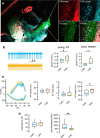

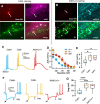

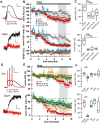

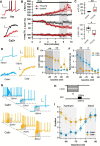


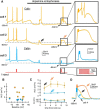
Similar articles
-
Muscarinic Receptor Activation Preferentially Inhibits Rebound in Vulnerable Dopaminergic Neurons.J Neurosci. 2025 Apr 16;45(16):e1443242025. doi: 10.1523/JNEUROSCI.1443-24.2025. J Neurosci. 2025. PMID: 40000233
-
Enhanced Sensitivity to Hyperpolarizing Inhibition in Mesoaccumbal Relative to Nigrostriatal Dopamine Neuron Subpopulations.J Neurosci. 2017 Mar 22;37(12):3311-3330. doi: 10.1523/JNEUROSCI.2969-16.2017. Epub 2017 Feb 20. J Neurosci. 2017. PMID: 28219982 Free PMC article.
-
Cocaine Selectively Reorganizes Excitatory Inputs to Substantia Nigra Pars Compacta Dopamine Neurons.J Neurosci. 2018 Jan 31;38(5):1151-1159. doi: 10.1523/JNEUROSCI.1975-17.2017. Epub 2017 Dec 20. J Neurosci. 2018. PMID: 29263240 Free PMC article.
-
Converging roles of ion channels, calcium, metabolic stress, and activity pattern of Substantia nigra dopaminergic neurons in health and Parkinson's disease.J Neurochem. 2016 Oct;139 Suppl 1(Suppl Suppl 1):156-178. doi: 10.1111/jnc.13572. Epub 2016 Mar 23. J Neurochem. 2016. PMID: 26865375 Free PMC article. Review.
-
The electrophysiological actions of dopamine and dopaminergic drugs on neurons of the substantia nigra pars compacta and ventral tegmental area.Life Sci. 1992;51(10):711-8. doi: 10.1016/0024-3205(92)90479-9. Life Sci. 1992. PMID: 1355254 Review.
Cited by
-
Dopamine Transporter Is a Master Regulator of Dopaminergic Neural Network Connectivity.J Neurosci. 2021 Jun 23;41(25):5453-5470. doi: 10.1523/JNEUROSCI.0223-21.2021. Epub 2021 May 12. J Neurosci. 2021. PMID: 33980544 Free PMC article.
-
T-type calcium channel enhancer SAK3 promotes dopamine and serotonin releases in the hippocampus in naive and amyloid precursor protein knock-in mice.PLoS One. 2018 Dec 20;13(12):e0206986. doi: 10.1371/journal.pone.0206986. eCollection 2018. PLoS One. 2018. PMID: 30571684 Free PMC article.
-
Distinct temporal difference error signals in dopamine axons in three regions of the striatum in a decision-making task.Elife. 2020 Dec 21;9:e62390. doi: 10.7554/eLife.62390. Elife. 2020. PMID: 33345774 Free PMC article.
-
Gi/o protein-coupled receptors in dopamine neurons inhibit the sodium leak channel NALCN.Elife. 2018 Dec 17;7:e40984. doi: 10.7554/eLife.40984. Elife. 2018. PMID: 30556810 Free PMC article.
-
Dendritic involvement in inhibition and disinhibition of vulnerable dopaminergic neurons in healthy and pathological conditions.Neurobiol Dis. 2022 Oct 1;172:105815. doi: 10.1016/j.nbd.2022.105815. Epub 2022 Jul 9. Neurobiol Dis. 2022. PMID: 35820645 Free PMC article. Review.
References
-
- Aizenman CD, Linden DJ (1999) Regulation of the rebound depolarization and spontaneous firing patterns of deep nuclear neurons in slices of rat cerebellum. J Neurophysiol 82:1697–1709. - PubMed
Publication types
MeSH terms
Substances
LinkOut - more resources
Full Text Sources
Other Literature Sources
Molecular Biology Databases
Research Materials
Miscellaneous
